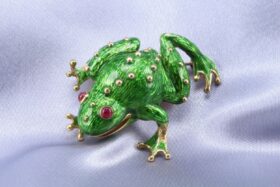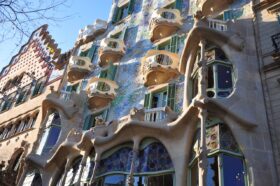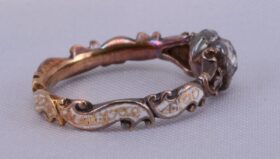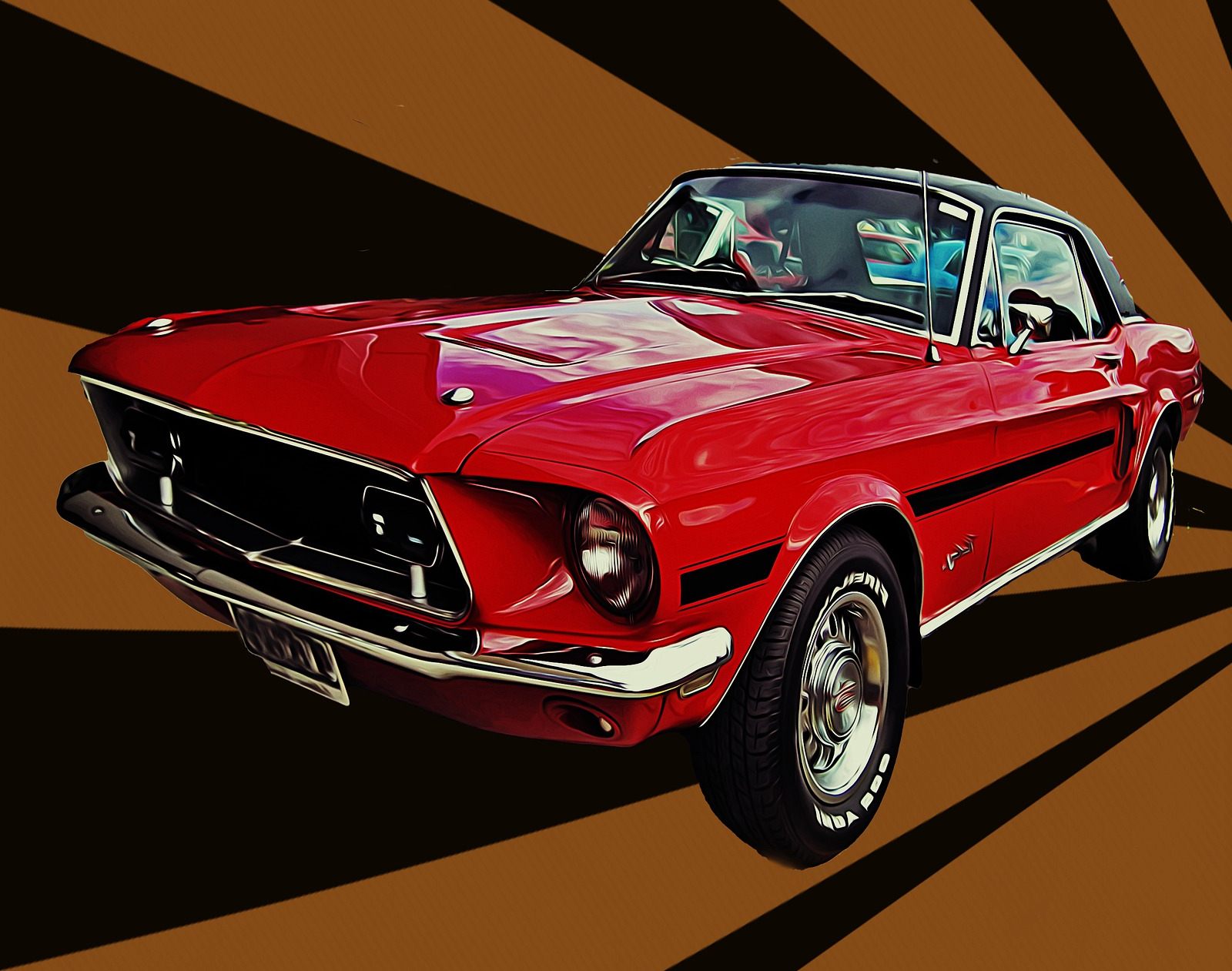
02 Apr Famous Jewelry Designers of the 1960s & ’70s
Seen Above: The Ford Mustang, which was introduced in 1964.
The 1960s and 1970s don’t seem that long ago to people who grew up then. But that period is now just as far back as the Roaring ’20s were to us in Generation X when we were young. The ’60 and ’70s were, of course, a time of great cultural and social change, and this was reflected in the design of cars, architecture, fashion, and fine jewelry.
Car design at this time was heavily influenced by the space race and the futuristic aesthetic that it inspired. This led to the development of “muscle cars” that featured sleek, aerodynamic designs and powerful engines (for example, the Ford Mustang, Chevrolet Camaro, and Dodge Charger).
The modernist movement in architecture, which had its roots in the early 20th century, continued to influence design in the 1960s and 1970s. This led to the development of many iconic buildings that featured clean lines, simple shapes, and a focus on functionality. Some of the most famous architects of this era include Le Corbusier, Mies van der Rohe, and Frank Lloyd Wright.
Fashion was heavily influenced by the counterculture, such as the hippie movement and the mod subculture. This led to the development of many iconic styles, including bell-bottoms, mini skirts, tie-dye patterns, and platform shoes. Fashion designers such as Mary Quant, Yves Saint Laurent, and Diane von Furstenberg first made a name for themselves during this period.
As for fine jewelry design, this was heavily influenced by the motifs and methods that were explored by the Art Deco jewelry designers (as well as the Art Nouveau jewelry designers) of the early 20th century. This led to the development of many pieces that featured geometric shapes, bold colors, and intricate patterns, while at the same time designers moved away from traditional styles to embrace a more eclectic, avant-garde approach.
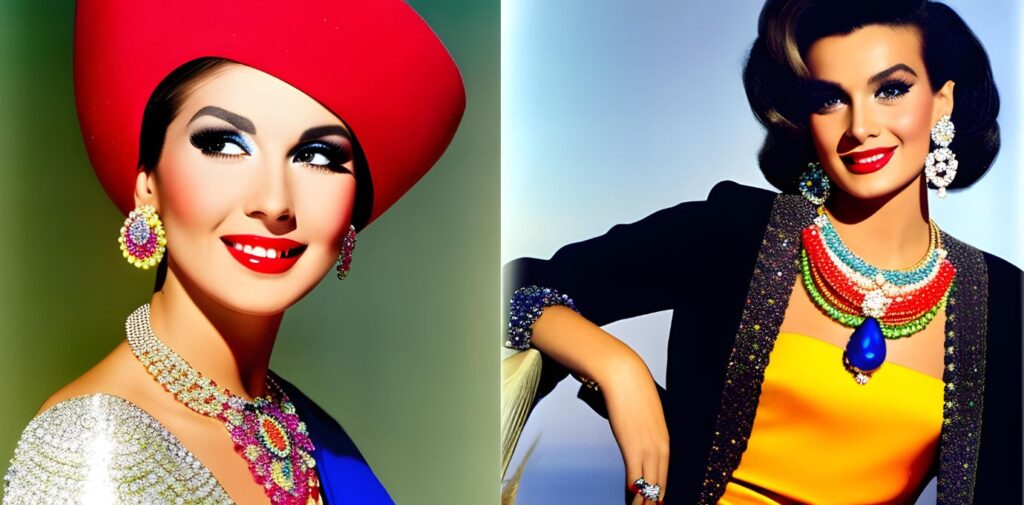
Famous 1960s & ’70s Jewelry Designers
In the 1960s and 1970s, jewelry design underwent a significant shift. This was a time of experimentation and innovation in the jewelry industry, with designers pushing the boundaries of what was considered acceptable in terms of design and materials. Large jewelry houses that previously had their largest followings in Europe, such as Van Cleef & Arpels and Buccellati, became increasing popular in the United States during this period. Here are a few of the most famous and innovative jewelry designers of the era.
David Webb
David Webb was an American jewelry designer who became famous in the 1960s and 1970s for his bold, colorful pieces that incorporated a variety of materials and techniques. Webb’s designs were often inspired by nature, with many pieces featuring animal motifs such as elephants, snakes, and tigers.
One of the signature techniques of Webb’s jewelry was enamel work, which he used to create bright, vibrant colors on his pieces. He was known for his use of large, chunky gemstones, which he often combined with gold, platinum, and other precious metals to create pieces that were both striking and luxurious.
Despite his success, Webb remained fiercely independent and committed to his craft. He ran his own workshop and was involved in every aspect of the design and production process, from sketching out new designs to overseeing the work of his craftsmen.
Webb passed away in 1975 at the age of 50, but his legacy lives on in his iconic designs, many of which remain highly sought-after by collectors and enthusiasts. Today, the David Webb brand continues to produce high-end jewelry that is inspired by Webb’s original designs, and his pieces are featured in some of the world’s most prestigious museums and collections.
Aldo Cipullo
Aldo Cipullo was an Italian-born jewelry designer who worked for several high-end jewelry companies, including David Webb and Tiffany & Co. In the late 1960s, he was hired by Cartier to design a new line of jewelry that would appeal to a younger, more fashion-forward audience. Working at Cartier, Cipullo created perhaps the most iconic piece of ’60s and ’70s jewelry: the Love bracelet.
Introduced in 1969, the Love bracelet is a simple, unisex bangle made of two halves that fasten together with a tiny screwdriver. The design features a series of screw heads around the circumference of the bracelet, which are meant to evoke the idea of a piece of hardware that is used to secure two things together.
The Love bracelet quickly became a sensation and was embraced by celebrities and fashion icons around the world. Its popularity was due in part to its simple, modern design, but also to its message of love and commitment. The bracelet was often given as a symbol of love between two people, and the act of fastening the bracelet together with the screwdriver was seen as a kind of modern-day wedding ceremony.
Today, the Love bracelet remains a popular and iconic piece of jewelry, and has been reinterpreted in a variety of materials and finishes. It is widely recognized as one of Aldo Cipullo’s most important and enduring designs, and is a testament to his talent for creating timeless, meaningful jewelry that speaks to people on a personal level.

Oscar Heyman
Oscar Heyman is a famous jewelry brand that was founded in 1912 by Oscar and Nathan Heyman, two brothers who emigrated from Latvia to the United States. The brand is known for its exquisite jewelry pieces, which are crafted using only the finest gemstones and metals.
The Heyman brothers initially started their business by creating jewelry pieces for other brands, but soon gained recognition for their exceptional craftsmanship and attention to detail. They opened their own workshop in New York City in the 1920s, and began creating their own line of jewelry, which quickly gained a reputation for its high quality and exceptional beauty.
One of the things that sets Oscar Heyman apart from other jewelry brands is their commitment to craftsmanship. Every piece of jewelry is created by hand in their workshop, and the brand uses only the finest gemstones and precious metals. The attention to detail is evident in every piece, from the intricate design work to the stunning stones.
The brand became famous in the 1960s, when it began creating pieces for some of the most famous and influential people in the world, including Jackie Kennedy, Elizabeth Taylor, and the Duchess of Windsor. Their jewelry has been featured in major exhibitions at museums around the world, and the brand continues to be celebrated for its exceptional beauty and craftsmanship.
Jean Schlumberger
Jean Schlumberger was a French jewelry designer whose designs were characterized by their whimsical and imaginative motifs, which often incorporated natural elements such as flowers, leaves, and animals. He was also known for his use of colorful gemstones and unusual materials, such as seashells and enamel.
In the 1950s, Schlumberger moved to the United States and began designing for the legendary jewelry house of Tiffany & Co. His designs for Tiffany quickly gained a following among the social elite, especially during the 1960s, and he became known for his extravagant and distinctive pieces.
Some of Schlumberger’s most famous designs for Tiffany include the “Bird on a Rock” brooch, which features a diamond-studded bird perched on a yellow diamond, and the “Starfish” bracelet, which features a stunning array of colored gemstones set in the shape of a starfish.
Schlumberger’s work was also highly sought after by Hollywood celebrities, including Audrey Hepburn, Marilyn Monroe, and Elizabeth Taylor. He continued to work for Tiffany until his death in 1987, leaving behind a legacy of stunning and imaginative jewelry designs.

Elsa Peretti
Elsa Peretti is an Italian jewelry designer who rose to fame in the 1970s for her sculptural, organic designs. Her work is characterized by its simplicity and elegance, and often features abstract shapes and forms that are inspired by nature.
Peretti began her career as a model in New York City in the 1960s, but soon transitioned to jewelry design after meeting the famous designer Halston, who encouraged her to pursue her creative interests. She began designing jewelry for Tiffany & Co. in the early 1970s, and quickly became known for her innovative designs that broke with tradition.
One of Peretti’s most famous designs is the Bone cuff, which is a simple, curved cuff made of silver or gold that is designed to fit the natural contours of the wrist. The Bone cuff was a sensation when it was first introduced, and is still considered one of Peretti’s most iconic designs.
Peretti’s other notable designs include the Bean pendant, which is a small, rounded pendant made of gold or silver that is meant to resemble a kidney bean, and the Open Heart pendant, which is a simple, heart-shaped pendant that is open at the top. Today, Elsa Peretti’s jewelry continues to be sold by Tiffany & Co. and is highly sought-after by collectors and fashion enthusiasts around the world.
Bulgari
Bulgari is an Italian luxury brand that has been creating high-end jewelry since its founding in 1884. In the 1970s, Bulgari was at the forefront of the fashion world, creating bold, colorful pieces that were inspired by ancient Roman and Greek art.
During this time, Bulgari began to incorporate larger and more unusual gemstones into its designs, such as amethysts, citrines, and peridots, which gave its pieces a distinctive look and feel. The brand also experimented with new materials, such as stainless steel and leather, which helped to broaden its appeal beyond the traditional high-end jewelry market.
One of the most iconic designs from this era was the Tubogas bracelet, which featured a flexible, serpent-like band that was made of interlocking gold coils. The Tubogas bracelet was highly sought-after by fashion-conscious women around the world and remains a classic design today.
Another popular Bulgari design from the 1970s was the Serpenti collection, which featured serpent-inspired pieces made of gold and diamonds. These pieces were highly symbolic, with the serpent representing wisdom and rebirth in ancient Roman and Greek mythology.
Bulgari’s bold and colorful designs were a hit with celebrities and fashion icons of the time, such as Elizabeth Taylor and Sophia Loren, and the brand’s reputation for luxury and elegance continued to grow throughout the decade.
Sell Jewelry from the 1960s and ’70s
If you have vintage jewelry from the 1960s or ’70s that you would like to sell, contact C. Blackburn Jewelers in La Jolla. Our San Diego jewelry buyers specialize in buying both vintage and antique jewelry, especially signed pieces from classic jewelry designers such as David Webb, Jean Schlumberger, and the other designers and jewelry brands that we mentioned in the above article. Get a free cash appraisal by calling us at 858-251-3006 or send a message below.
Text Message & Photos:
619-723-8589


